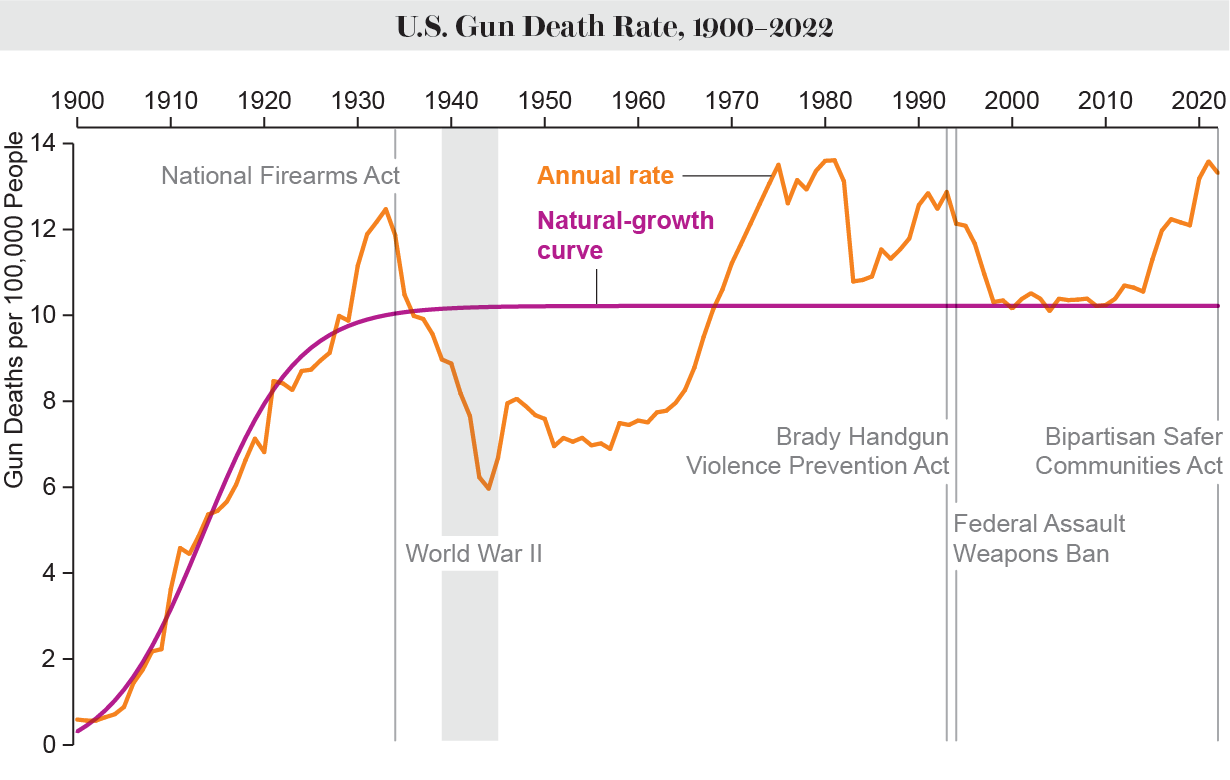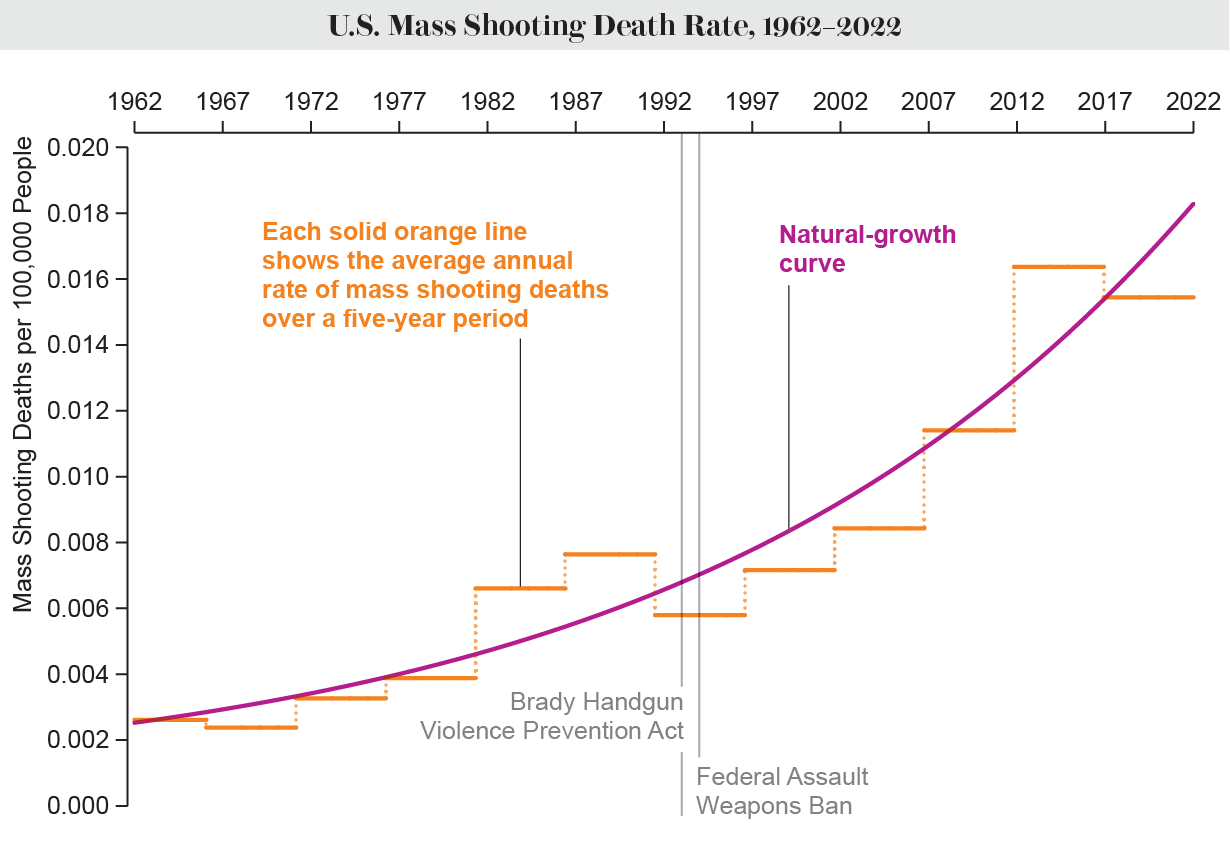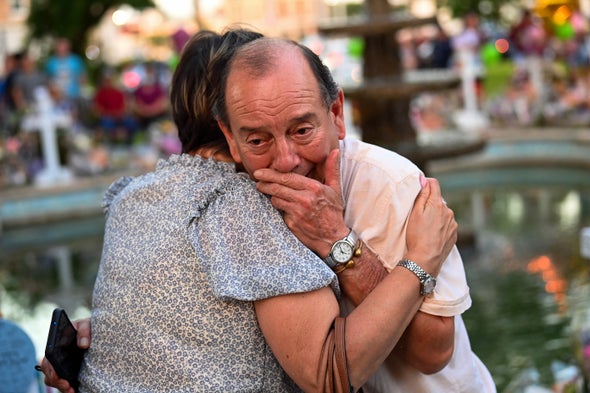In the past decade, mass killings at schools, nightclubs, places of worship and other once unimaginable settings have shaken the U.S. While mass shootings comprise 0.1 percent of gun deaths nationwide, they appear headed on a grim upward spiral.
This year has been the worst recorded for mass-shooting incidents in the U.S., according to Northeastern University’s database, with 33 by mid-August. Mass shootings are growing exponentially, demanding urgent attention. Other gun deaths, including homicides, suicides and accidents, are three orders of magnitude more numerous, but in contrast have stabilized, reaching a kind of equilibrium over the past century.
That means—despite the grip that gun politics have on U.S. lawmakers—a sharp break is needed from “business as usual” gun laws to derail the exponential increase in mass-shooting murders.
Throughout history, U.S. society has grappled with limiting deaths resulting from the unlawful and inappropriate use of firearms. In the 20th century, annual gun-related deaths steadily increased until the early 1930s, when they reached around 10per 100,000 people (see “U.S. Gun Death Rate” chart). The rate stabilized thereafter despite the increasing availability and effectiveness of guns, oscillating around that homeostatic equilibrium, a self-regulating process that maintains its stability while adjusting to changing outside conditions. In subsequent decades both laws and wartime partly suppressed gun death numbers for some time, while relaxation of gun controls led to increases.
The overall evolution of this gun death rate followed a trend that can be generally described by an S-shaped natural-growth curve, a “logistic” pattern (see the purple line in the chart). Such trends are widely observed in ecology where a species’ population grows under some form of competition, for example, among rabbits kept in a fenced-off grass field. Such populations first grow exponentially but then slow down as food becomes scarce, and finally reach a ceiling that reflects the capacity of their niche to accommodate the final population. Seen in this context, U.S. society can be seen as a competition between law enforcement and unlawful gun users that has led to this 10-per-100,000-gun-deaths final ceiling.

U.S. society's response to gun-related fatalities has been sensitive to deviations from this gun death ceiling. The “St. Valentine's Day Massacre,” in 1931 in Chicago, for example, triggered the National Firearms Act. The Brady Handgun Violence Prevention Act of 1993 and the Federal Assault Weapons Ban of 1994 came in response to an upward deviation of gun deaths around the mid-1990s, and effectively curbed that increase. But the latter expired in 2004, setting the stage for a new upward fluctuation. In fact, gun deaths have been rising again since 2011, as shown in the chart. Most likely the Bipartisan Safer Communities Act signed into law by Biden on June 25, 2022, and possibly other similar legislation will reverse the overall gun death trend, which saw its highest number ever recorded in the previous year at nearly 49,000 deaths.
Remarkably, for an entire century, various obvious and less obvious mechanisms have regulated the gun death toll, with events like war leading to an extended downward fluctuation. It appears that around 10 deaths annually per 100,000 has been deemed by society as an acceptable price to pay for gun usage, perhaps reflecting the perceived value U.S. citizens place on firearms. A similar phenomenon has evolved in the number of U.S. deaths from car accidents, which eventually also leveled out at around 10 per 100,000 population.
But mass-shooting deaths, defined here as incidents resulting in at least four deaths excluding the offenders, are another matter: they have been growing exponentially. Each mass shooting serves as an inspiration to potential perpetrators, setting off a chain reaction of more such murders in the future. In essence, mass shootings possess the capacity to multiply like a species, with the rate of new incidents being proportional to the existing tally—this is the very essence of exponential growth. However, the number of deaths from mass shootings remains still relatively small, and society's corrective action, which often seems triggered by the publicity surrounding mass shootings, is in fact a response to an upward excursion of the overall number of gun deaths and not to mass shootings. Gun-control measures have little impact on the evolution of mass shootings. As we see in the “U.S. Mass Shooting Death Rate” chart, BHVPA and FAWB produced only a small temporary dent on the pattern that otherwise conforms to an exponential trend. Loud public outcry after a mass shooting may render people more careful with their guns but does not deter potential mass shooters from carrying out their sinister intentions.
Conventional wisdom holds that even defining mass shootings is hard, and they are subject to “fluctuations,” in the words of criminologist James Fox, who suggested that “the recent spike may prove to be short-lived” in a recent paper. The natural law of growth in competition suggests this optimism is misguided: Mass shootings follow their own S-shaped natural-growth curve different from the one for all gun deaths shown earlier. Consider the growing trend illustrated by data from the Violence Project, a nonpartisan, nonprofit organization dedicated to reducing violence through research. The logistic curve fitted on a five-year average of these numbers is still in its very early stages, which makes the pattern so far indistinguishable from the exponential pattern mentioned earlier. In such cases, we cannot reliably estimate a final ceiling for this S-shaped curve. But one thing is certain: the final death rate from mass shootings will far surpass the current toll. But by how much and by when depends on what we do between now and then.

Such natural-growth curves reflect laws of nature and will proceed to completion as long as the conditions remain unchanged. That implies that we will continue with the same kind of incremental gun-control measures applied in the past, in which case the projected curve will follow its estimated trajectory without significant deviations. We’ve seen this elsewhere in the U.S., where drug overdose poisoning, for example, has been growing exponentially over the last 40 years. Incremental legislative actions at the state or federal level have already influenced the data and have been factored into the growth curve estimation.
To observe a deviation from this curve in the future, unprecedented action is required.
This may entail substantial changes to the American Constitution, or its interpretation, or wider weapons bans than the one that expired in 2004. Without actions of this magnitude, we must anticipate “business as usual,” with the curve persisting exponentially as projected. Consequently, mass shootings could evolve into a menacing societal issue akin to suicides and other homicides, causing the overall number of deaths to shift from a flat horizontal line to an exponential increase. At that point, society may indeed respond with drastic measures, but it will already have paid far too high a price.
This is an opinion and analysis article, and the views expressed by the author or authors are not necessarily those of Scientific American.

